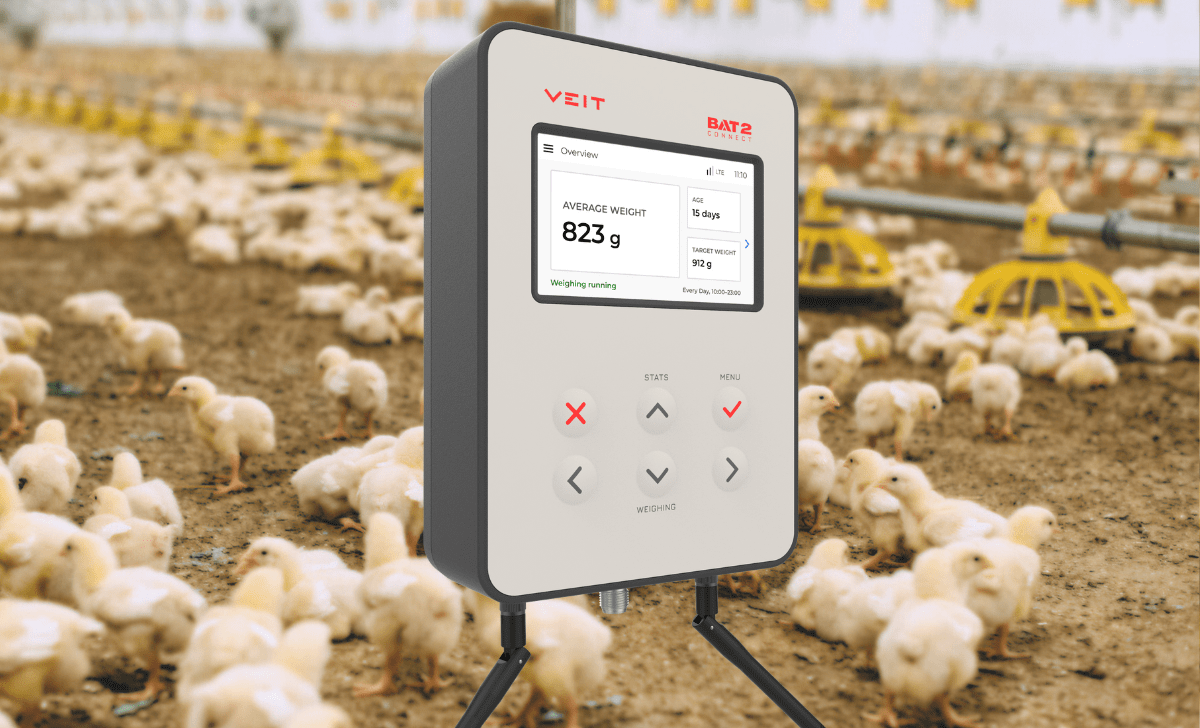Modern broiler chicken farming faces mounting pressure to produce more with less. Feed costs now represent 70% of total production expenses. Traditional weighing methods and guesswork in feed management are no longer sustainable practices.
The solution lies in automated data collection systems that track a flock’s growth in real time. This technology represents the first essential step toward building a truly modern poultry operation.
The Hidden Cost of Manual Broiler Management
Traditional broiler farms rely on weekly manual weighing sessions. Farmers capture just 2% of their flock for these samples. While it serves numerous purposes, especially the opportunity to physically assess birds while weighing and sorting, this approach misses critical growth variations that occur between weighing days.
Consider a typical scenario: Your broiler feed chart suggests 50 grams per bird daily. But without daily weight data, you cannot adjust portions based on actual growth rates. Some birds receive too much feed while others get too little.
This inefficiency costs money, most commonly in lost profit potential through its impact on FCR. Studies show a mere 0.1 improvement in Feed Conversion Ratio (FCR) can translate to a substantial 5-8% increase in profit for producers.
What Modern Broiler Chicken Farms Track Daily
Smart farms monitor several key metrics every single day:
Individual bird weights provide the foundation for all management decisions. Each broiler chicken follows a predictable growth curve when properly fed.
Feed conversion ratios reveal how efficiently birds convert feed into body weight. Automated systems calculate this ratio continuously rather than waiting for weekly manual checks.
Growth uniformity ensures the entire flock develops consistently. Automatic scales detect weight variations immediately, allowing farmers to adjust feeding strategies before problems escalate.
Environmental correlations help farmers link weight gain to factors like temperature, humidity, and lighting conditions. This data helps optimize housing conditions for maximum growth.
Types of Broiler Feed and Automated Delivery
Modern farms use sophisticated feeding programs that change based on real-time weight data. The most common types of broiler feed include:
Starter feeds contain 20-23% protein for rapid early growth. Chicks typically consume 25-30 grams daily during their first two weeks.
Grower feeds reduce protein to 19-20% as birds develop muscle mass. Daily consumption increases dramatically to 50-200 grams per bird as they mature.
Finisher feeds contain 15-18% protein to maximize meat production while controlling fat deposition. Mature birds consume 200-240+ grams daily.
Automated systems adjust these amounts based on actual weight gain rather than estimated consumption patterns.
How Much Feed Per Broiler Chicken Actually Varies
The answer depends on current body weight, growth stage, and environmental conditions. Traditional broiler feed charts provide general guidelines, but smart farms customize portions for their specific situations.
Automatic weighing platforms collect thousands of data points weekly. This information reveals that feed requirements can vary significantly between individual birds of the same age. For example, at 6 weeks of age, daily consumption ranges from 180-220 grams per bird depending on genetics and environmental factors.
A properly calibrated automatic scale system can detect these variations and signal feeding adjustments immediately. Given the amount of labor it would require, manual weighing simply cannot feasibly provide this level of feedback.
What to Feed Broiler Chickens Based on Data
Automated systems reveal that successful broiler nutrition extends beyond basic feed types. Smart farms track:
Amino acid ratios based on actual growth rates rather than theoretical requirements.
Energy density adjustments for seasonal temperature variations.
Vitamin and mineral supplementation calibrated to flock performance metrics.
Feed texture optimization based on consumption patterns detected by monitoring systems.
This level of precision was impossible with manual weighing and feeding systems.
The Economic Impact of Automation
Farms implementing automated data collection systems typically see results within 60 days. Key improvements include:
Feed efficiency gains of 4% through optimized Feed Conversion Ratio (FCR) via precise portion control.
Improved growth rates of 3-5% due to consistent nutrition delivery.
Labor savings of 10 or more collective man hours previously spent on daily manual weighing and data entry.
Reduced mortality of 1-2% through early detection of health issues.
Taking the First Step Toward Farm Modernization
The transition to automated broiler management begins with installing reliable weighing systems. Modern poultry scales like the BAT2 provide the foundation for data-driven decisions.
These systems require minimal training and integrate seamlessly with existing farm infrastructure. Most installations are operational within one day.
The investment pays for itself through improved feed efficiency and reduced labor costs. More importantly, it positions your operation for future technological advances in precision agriculture.
Smart broiler farms are not a distant future concept. They represent the competitive advantage that separates profitable operations from those struggling with traditional methods.
The data revolution in poultry farming starts with accurate, automated weighing. Everything else builds from that foundation.
Ready to modernize your broiler operation? Learn how the BAT2 automatic scale system can transform your farm’s efficiency and profitability at poultryscales.com/bat2.
